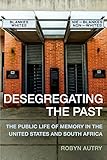Desegregating the Past : The Public Life of Memory in the United States and South Africa / Robyn Autry.
Material type: TextPublisher: New York, NY : Columbia University Press, [2017]Copyright date: ©2017Description: 1 online resource (272 p.) : 25 b&w photographsContent type:
TextPublisher: New York, NY : Columbia University Press, [2017]Copyright date: ©2017Description: 1 online resource (272 p.) : 25 b&w photographsContent type: - 9780231177580
- 9780231542517
- African Americans -- Historiography
- Black people -- South Africa -- Historiography
- Blacks -- South Africa -- Historiography
- Historical museums -- South Africa
- Historical museums -- United States
- Memory -- Social aspects -- South Africa
- Memory -- Social aspects -- United States
- Racism -- South Africa -- Historiography
- Racism -- United States -- Historiography
- SOCIAL SCIENCE / Sociology / General
- 305.896073 23
- E184.65 .A88 2017
- E184.65 .A88 2019
- online - DeGruyter
- Issued also in print.
| Item type | Current library | Call number | URL | Status | Notes | Barcode | |
|---|---|---|---|---|---|---|---|
 eBook
eBook
|
Biblioteca "Angelicum" Pont. Univ. S.Tommaso d'Aquino Nuvola online | online - DeGruyter (Browse shelf(Opens below)) | Online access | Not for loan (Accesso limitato) | Accesso per gli utenti autorizzati / Access for authorized users | (dgr)9780231542517 |
Browsing Biblioteca "Angelicum" Pont. Univ. S.Tommaso d'Aquino shelves, Shelving location: Nuvola online Close shelf browser (Hides shelf browser)

|

|

|

|

|

|

|
||
| online - DeGruyter Radiation Nation : Three Mile Island and the Political Transformation of the 1970s / | online - DeGruyter How the Suburbs Were Segregated : Developers and the Business of Exclusionary Housing, 1890-1960 / | online - DeGruyter Teenage Suicide Notes : An Ethnography of Self-Harm / | online - DeGruyter Desegregating the Past : The Public Life of Memory in the United States and South Africa / | online - DeGruyter Identifying with Nationality : Europeans, Ottomans, and Egyptians in Alexandria / | online - DeGruyter Critics, Coteries, and Pre-Raphaelite Celebrity / | online - DeGruyter The Reincarnated Giant : An Anthology of Twenty-First-Century Chinese Science Fiction / |
Frontmatter -- Contents -- Acknowledgments -- List of Museums Visited -- List of Abbreviations -- Introduction: Desegregating the Past -- 1. Memory Entrepreneurs: History in the Making -- 2. The Curated Past: Remembering the Collective -- 3. Managing Collective Representations -- 4. Memory Deviants: Breaking the Collective -- Conclusion: Museumification of Memory -- Notes -- Selected Bibliography -- Index
restricted access online access with authorization star
http://purl.org/coar/access_right/c_16ec
At the Apartheid Museum in Johannesburg, South Africa, visitors confront the past upon arrival. They must decide whether to enter the museum through a door marked "whites" or another marked "non-whites." Inside, along with text, they encounter hanging nooses and other reminders of apartheid-era atrocities. In the United States, museum exhibitions about racial violence and segregation are mostly confined to black history museums, with national history museums sidelining such difficult material. Even the Smithsonian's National Museum of African American History and Culture is dedicated not to violent histories of racial domination but to a more generalized narrative about black identity and culture. The scale at which violent racial pasts have been incorporated into South African national historical narratives is lacking in the U.S. Desegregating the Past considers why this is the case, tracking the production and display of historical representations of racial pasts at museums in both countries and what it reveals about underlying social anxieties, unsettled emotions, and aspirations surrounding contemporary social fault lines around race. Robyn Autry consults museum archives, conducts interviews with staff, and recounts the public and private battles fought over the creation and content of history museums. Despite vast differences in the development of South African and U.S. society, Autry finds a common set of ideological, political, economic, and institutional dilemmas arising out of the selective reconstruction of the past. Museums have played a major role in shaping public memory, at times recognizing and at other times blurring the ongoing influence of historical crimes. The narratives museums produce to engage with difficult, violent histories expose present anxieties concerning identity, (mis)recognition, and ongoing conflict.
Issued also in print.
Mode of access: Internet via World Wide Web.
In English.
Description based on online resource; title from PDF title page (publisher's Web site, viewed 02. Mrz 2022)


